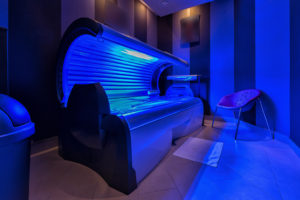
Amid Michigan’s cold and cloudy winters, a suntan can be hard to come by.
And unless you’ve got a trip to Barbados on your calendar, you might be thinking about creative ways to add a little glow to your skin.
But if you’re thinking about visiting a tanning salon, you may want to rethink that.
Indoor tanning presents more risk than many people realize, including a higher risk of developing skin cancers, according to the nonprofit Skin Cancer Foundation.
And tanning beds are not safer than sun exposure—they can emit 10 to 15 times more UV radiation than the sun, even at the sun’s peak intensity.
“When you go to a salon, you are getting exposure on all areas of your body—and thus you are risking getting burned all over your body,” said Katherine Foster, DO, a specialist in pediatric dermatology at Corewell Health Helen DeVos Children’s Hospital. “When in the sun, some areas of your body are covered with clothing.”
Some states have enacted laws restricting the use of tanning salons, such as prohibiting anyone age 18 and younger from using these services.
Younger people and those with lighter skin colors are at a much greater risk of sunburn and skin cancer if they use tanning beds, Dr. Foster said.
Another downside: Tanning beds can cause skin discoloration and premature wrinkling of the skin, as well as causing sunspots. This can accelerate aging, Dr. Foster said.
Tanning can also be an addiction, just like smoking, she said. That’s why the younger you start, the greater the risk of developing cancer.
The good news: Fewer people are using tanning beds these days, according to the Skin Cancer Foundation. Use of indoor tanning among U.S. high schoolers dropped by 53 percent from 2009 to 2015.
“I think the overall popularity of tanning salons is wearing off because most people are being educated about the dangers of tanning beds,” Dr. Foster said.
If you’ve had skin cancer or currently have it, it’s all the more reason to avoid indoor tanning.
Dr. Foster instead recommends getting a temporary tan with self-tanners, such as foams, creams and towels —it’s a much safer alternative.
“At this time, we are not aware of any serious dangers from tanning lotions,” she said.
 /a>
/a>
 /a>
/a>
 /a>
/a>